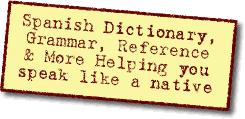Ask a Question(Create a thread) |
|
|||||||
Necesito traducir lo siguiente con precisión.Translate a sentence or longer piece of text. For single words or idioms, use the vocabulary forum. |
 |
|
|
Thread Tools |
|
#1
|
|||
|
|||
|
Necesito traducir lo siguiente con precisión.
Saludos cordiales. contexto: me refiero a una mujer.
Busco traducir esto: ¿Has visto a melody en persona? ¿Has hablado con ella? (Do you Have seen melody in person? Do you Have spoken with her?) ¿Qué piensas sobre melody? ¿Qué le dirías a ella? (What do you think about melody? What would you say to her?) ¿Has recibido un autógrafo de Melody perkins? (Do you have received an autograph from Melody? Si tienes información sobre Melody, envíame un mensaje. (If you have information about Melody, send me a message.) Last edited by bc7; January 06, 2014 at 12:42 PM. |
|
Get rid of these ads by registering for a free Tomísimo account.
|
|
#2
|
|||
|
|||
|
'Do you have seen melody in person' is incorrect. What are you trying to say here?
You're missing an accent on the second 'que'. It's misspelt. Also, your English has flaws. Hopefully Rusty can give you more information. 
Last edited by Liquinn3; January 06, 2014 at 12:27 PM. |
 |
| Tags |
| mel |
«
Previous Thread
|
Next Thread
»
| Link to this thread | |
|
|
|||||||
 Similar Threads
Similar Threads
|
||||
| Thread | Thread Starter | Forum | Replies | Last Post |
| Necesito un poquito de ayuda con el subjuntivo | Esperar | Grammar | 6 | September 24, 2013 12:41 PM |
| En la semana siguiente o a la semana siguiente? | Caramelita | Grammar | 12 | May 14, 2013 12:26 PM |
| ¡Necesito ayuda con la carta a mi amigo! | JCBrotherhood | Practice & Homework | 1 | November 13, 2011 11:56 PM |
| Necesito ayuda con estos términos musicales | lblanco | Translations | 6 | April 12, 2011 08:52 AM |
| Necesito ayuda con un párrafo de don Quijote | Liliacam | Practice & Homework | 6 | January 20, 2010 11:54 AM |
All times are GMT -6. The time now is 05:04 AM.









